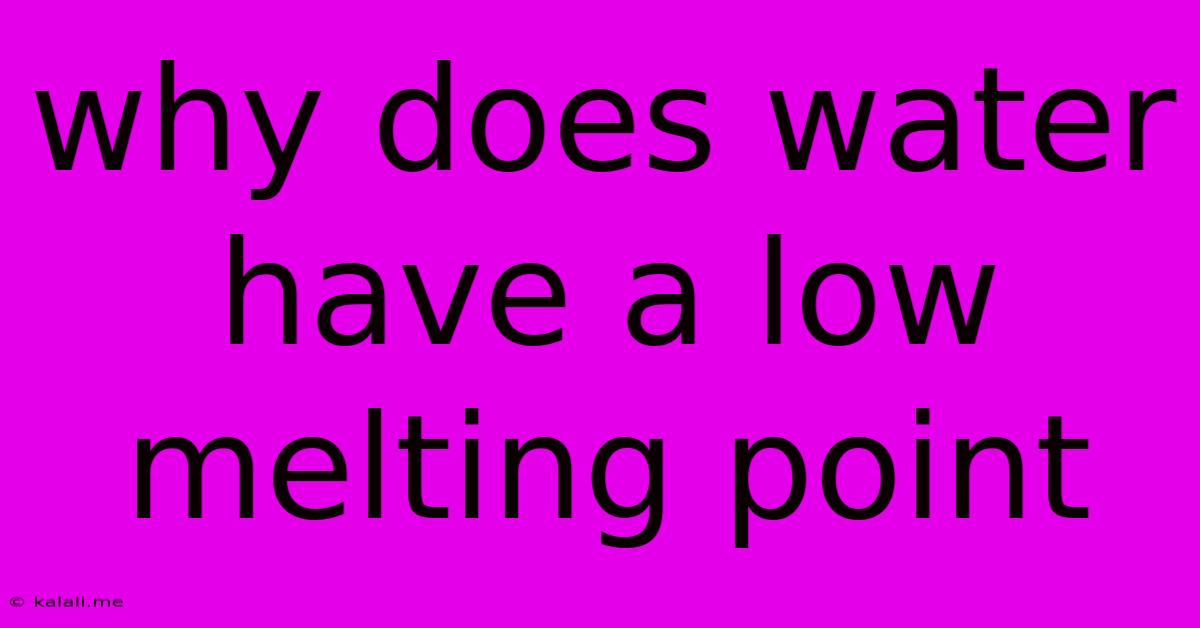Why Does Water Have A Low Melting Point
Kalali
May 19, 2025 · 3 min read

Table of Contents
Why Does Water Have a Low Melting Point? A Deep Dive into Hydrogen Bonding
Water, a seemingly simple molecule (H₂O), exhibits properties far more complex than its chemical formula suggests. One such fascinating anomaly is its relatively low melting point of 0°C (32°F) compared to other similar molecules. This seemingly simple question opens a door to understanding the crucial role of hydrogen bonding in shaping the unique characteristics of water. This article will explore the underlying reasons behind water's low melting point, contrasting it with similar compounds and delving into the science behind its unusual behavior.
What is a Melting Point?
Before diving into the specifics of water, let's briefly define melting point. The melting point is the temperature at which a solid transitions into a liquid state. This transition occurs when the thermal energy overcomes the intermolecular forces holding the molecules in a fixed crystalline structure. The strength of these forces directly impacts the melting point; stronger forces require more energy (higher temperature) to break.
Why is Water's Melting Point Low? The Role of Hydrogen Bonding
Unlike many other molecules of similar molecular weight, water's melting point is surprisingly low. This is primarily attributed to the relatively weak nature of the intermolecular forces holding water molecules together in ice. While water molecules are held together by covalent bonds (strong bonds within the molecule), the interactions between water molecules are primarily due to hydrogen bonds.
Hydrogen bonds are a special type of dipole-dipole attraction that occurs when a hydrogen atom bonded to a highly electronegative atom (like oxygen in water) is attracted to another electronegative atom in a nearby molecule. While individually weaker than covalent bonds, the cumulative effect of numerous hydrogen bonds in water creates a significant cohesive force.
However, the crucial point is that hydrogen bonds are weaker than other intermolecular forces like ionic bonds or covalent bonds. Therefore, less energy is required to break these bonds and transition ice into liquid water, resulting in a lower melting point compared to substances with stronger intermolecular forces.
Comparison with Other Molecules
Let's compare water to other molecules with similar molecular weights:
-
Hydrogen sulfide (H₂S): Despite having a similar molecular structure to water, H₂S has a much lower melting point (-85.5°C). This is because sulfur is less electronegative than oxygen, resulting in weaker hydrogen bonding and weaker intermolecular forces.
-
Methane (CH₄): Methane, with a similar molecular weight to water, has an extremely low melting point (-182.5°C). This is due to the absence of hydrogen bonding; methane molecules only interact through weak London dispersion forces.
This comparison highlights the significant role of hydrogen bonding in influencing water's melting point. The relatively weaker hydrogen bonds, while still substantial, contribute to the lower energy needed for the phase transition from solid to liquid.
The Anomalous Properties of Water
Water's low melting point is just one of its many anomalous properties. These unique characteristics stem from its hydrogen bonding network:
-
High boiling point: The same hydrogen bonding that contributes to a low melting point also contributes to a relatively high boiling point, as strong intermolecular forces need to be overcome for the liquid to transition to a gas.
-
High surface tension: Hydrogen bonds create a strong cohesive force between water molecules, leading to high surface tension.
-
High specific heat capacity: Water can absorb a large amount of heat without a significant temperature increase, thanks to the energy required to disrupt its hydrogen bond network.
These properties are crucial for life on Earth, making water a unique and essential solvent for biological processes.
In conclusion, water's relatively low melting point is a consequence of the balance between its strong intramolecular covalent bonds and its weaker yet significant intermolecular hydrogen bonds. While hydrogen bonds contribute to water's unique properties, their relatively weak nature, compared to other intermolecular forces, ultimately leads to its surprisingly low melting point. Understanding this delicate balance is key to appreciating the remarkable and life-sustaining properties of water.
Latest Posts
Latest Posts
-
Play It By Ear Or Play It By Year
May 19, 2025
-
Can You Play Catan With 2 People
May 19, 2025
-
How To Soften Grout For Removal
May 19, 2025
-
How To Make A Carbonated Drink Flat
May 19, 2025
-
Can You Cook Chicken That Is Partially Frozen
May 19, 2025
Related Post
Thank you for visiting our website which covers about Why Does Water Have A Low Melting Point . We hope the information provided has been useful to you. Feel free to contact us if you have any questions or need further assistance. See you next time and don't miss to bookmark.